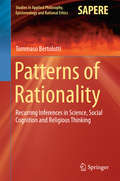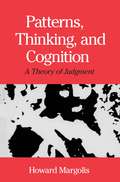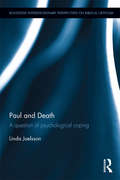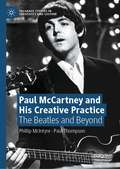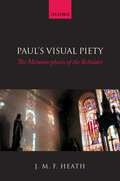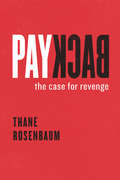- Table View
- List View
Patterns of Life History: The Ecology of Human Individuality (Applied Psychology Series)
by Michael D. Mumford Garnett S. Stokes William A. Owens Garnett StokesThis work summarizes an ongoing longitudinal study concerned with the nature of human differences as manifest in peoples' life histories. The traditional models for the description of human differences are reviewed, then contrasted with the presentation of alternative models. This volume is also one of the few to investigate different approaches to measurement procedures. Practical applications of these models and the results obtained in a 23 research effort are discussed.
Patterns of Life History: The Ecology of Human Individuality (Applied Psychology Series)
by Michael D. Mumford Garnett S. Stokes William A. Owens Garnett StokesThis work summarizes an ongoing longitudinal study concerned with the nature of human differences as manifest in peoples' life histories. The traditional models for the description of human differences are reviewed, then contrasted with the presentation of alternative models. This volume is also one of the few to investigate different approaches to measurement procedures. Practical applications of these models and the results obtained in a 23 research effort are discussed.
Patterns of Personality Judgment
by Rudolf CohenPatterns of Personality Judgment focuses on the significant lines of development that deals with systematic tendencies in personality judgments. This book consists of four chapters. Chapter 1 deals with the meaning of judgments in terms of their structural interrelations. The second chapter examines what degrees of agreement and extent different judges evaluate one another or evaluate persons whom they know only by photographs, handwriting, and self-descriptions. The utilization of individual items of information in judgment is deliberated in Chapter 3, while the subjective patterns of judgment are described in Chapter 4. This publication is a good source for students and researchers intending to acquire knowledge of personality judgment.
Patterns of Rationality: Recurring Inferences in Science, Social Cognition and Religious Thinking (Studies in Applied Philosophy, Epistemology and Rational Ethics #19)
by Tommaso BertolottiThis book proposes an applied epistemological framework for investigating science, social cognition and religious thinking based on inferential patterns that recur in the different domains. It presents human rationality as a tool that allows us to make sense of our (physical or social) surroundings. It shows that the resulting cognitive activity produces a broad spectrum of outputs, such as scientific models and experimentation, gossip and social networks, but also ancient and contemporary deities. The book consists of three parts, the first of which addresses scientific modeling and experimentation, and their application to the analysis of scientific rationality. Thus, this part continues the tradition of eco-cognitive epistemology and abduction studies. The second part deals with the relationship between social cognition and cognitive niche construction, i.e. the evolutionarily relevant externalization of knowledge onto the environment, while the third part focuses on what is commonly defined as “irrational”, thus being in a way dialectically opposed to the first part. Here, the author demonstrates that the “irrational” can be analyzed by applying the same epistemological approach used to study scientific rationality and social cognition; also in this case, we see the emergence of patterns of rationality that regulate the relationships between agents and their environment. All in all, the book offers a coherent and unitary account of human rationality, providing a basis for new conceptual connections and theoretical speculations.
Patterns of Supplementary Parenting (Child Nurturance)
by Marjorie J. Kostelnik Albert I. Rabin Lillian A. Phenice Anne K. SodermanThe United Nations' designation of 1979 as the International Year of the Child marked the first global effort undertaken to heighten awareness of the special needs of children. Activities initiated during this special year were designed to promote purposive and collaborative actions for the benefit of children throughout the world. Michigan State University's celebration of the International Year of the Child was held from Septem ber 1979 through June 1980. A variety of activities focused attention on the multiplicity of factors affecting the welfare of today's children as well as the children of the future. Many people involved with the university were concerned that benefits to children continue beyond the official time allocated to the celebration. The series Child Nurturance is one response to this concern. The first five volumes of Child Nurturance reflect directly the activities held on the Michigan State University campus and consist of original contributions from guest speakers and invited contributors. Subsequent biennial volumes will present original contributions from individuals representing such fields as anthropology, biology, education, human ecology, psychology, philosophy, sociology, and medicine. We hope the material presented in these volumes will promote greater understanding of children and encourage interdisciplinary inquiry into the individual, family, societal and cultural variables which influence their welfare and development. We would like to express both our thanks and our admiration for Margaret Burritt who not only typed the camera-ready copy for each of the volumes, but also served as general manager of the entire project.
Patterns, Thinking, and Cognition: A Theory of Judgment
by Howard MargolisWhat happens when we think? How do people make judgments? While different theories abound—and are heatedly debated—most are based on an algorithmic model of how the brain works. Howard Margolis builds a fascinating case for a theory that thinking is based on recognizing patterns and that this process is intrinsically a-logical. Margolis gives a Darwinian account of how pattern recognition evolved to reach human cognitive abilities. Illusions of judgment—standard anomalies where people consistently misjudge or misperceive what is logically implied or really present—are often used in cognitive science to explore the workings of the cognitive process. The explanations given for these anomalous results have generally explained only the anomaly under study and nothing more. Margolis provides a provocative and systematic analysis of these illusions, which explains why such anomalies exist and recur. Offering empirical applications of his theory, Margolis turns to historical cases to show how an individual's cognitive repertoire—the available cognitive patterns and their relation to cues—changes or resists changes over time. Here he focuses on the change in worldview occasioned by the Copernican discovery: not only how an individual might come to see things in a radically new way, but how it is possible for that new view to spread and become the dominant one. A reanalysis of the trial of Galileo focuses on social cognition and its interactions with politics. In challenging the prevailing paradigm for understanding how the human mind works, Patterns, Thinking, and Cognition is certain to stimulate fruitful debate.
Paul and Death: A Question of Psychological Coping (Routledge Interdisciplinary Perspectives on Biblical Criticism)
by Linda JoelssonThe concept of death, particularly violent death, is prevalent throughout the writings of Paul the Apostle. His letters in the New Testament address this topic from a variety of perspectives, some of which can appear to be almost contradictory. However, this need not be problematic. Paul and Death uses the method of psychological exegesis to show that the different attitudes toward death in Paul’s letters make for a much more coherent discourse if they are seen as an aid to individual and collective psychological coping. Taking the differences between each of Paul’s letters as its starting point, this study suggests that a variety of coping strategies in relation to death may be beneficial depending on the situation, the person, and the stage of the coping process. Drawing on psychologically-oriented hermeneutic theory, and theories about psychological coping in particular, the author argues that each case of psychological coping must be understood in its historical situation, and as strategies emanating from a specific person’s subjective appraisal. Combining theology and biblical studies with modern psychology, this book will be of particular interest to academics and students that are studying the relationship between Religion and notions of Death.
Paul and Death: A Question of Psychological Coping (Routledge Interdisciplinary Perspectives on Biblical Criticism)
by Linda JoelssonThe concept of death, particularly violent death, is prevalent throughout the writings of Paul the Apostle. His letters in the New Testament address this topic from a variety of perspectives, some of which can appear to be almost contradictory. However, this need not be problematic. Paul and Death uses the method of psychological exegesis to show that the different attitudes toward death in Paul’s letters make for a much more coherent discourse if they are seen as an aid to individual and collective psychological coping. Taking the differences between each of Paul’s letters as its starting point, this study suggests that a variety of coping strategies in relation to death may be beneficial depending on the situation, the person, and the stage of the coping process. Drawing on psychologically-oriented hermeneutic theory, and theories about psychological coping in particular, the author argues that each case of psychological coping must be understood in its historical situation, and as strategies emanating from a specific person’s subjective appraisal. Combining theology and biblical studies with modern psychology, this book will be of particular interest to academics and students that are studying the relationship between Religion and notions of Death.
Paul McCartney and His Creative Practice: The Beatles and Beyond (Palgrave Studies in Creativity and Culture)
by Phillip McIntyre Paul ThompsonThis book provides fresh insight into the creative practice developed by Paul McCartney over his extended career as a songwriter, record producer and performing musician. It frames its examination of McCartney’s work through the lens of the systems model of creativity developed by Mihaly Csikszentmihalyi and combines this with the research work of Pierre Bourdieu. This systems approach is built around the basic structures of idiosyncratic agents, like McCartney himself, and the choices he has made as a creative individual. It also locates his work within social fields and cultural domains, all crucial aspects of the creative system that McCartney continues to be immersed in. Using this tripartite system, the book includes analysis of McCartney’s creative collaborations with musicians, producers, artists and filmmakers and provides a critical analysis of the Romantic myth which forms a central tenet of popular music. This engaging work will have interdisciplinary appeal to students and scholars of the psychology of creativity, popular music, sociology and cultural studies.
Paul Tillich, Carl Jung and the Recovery of Religion
by John P. DourleyIs religion a positive reality in your life? If not, have you lost anything by forfeiting this dimension of your humanity? This book compares the theology of Tillich with the psychology of Jung, arguing that they were both concerned with the recovery of a valid religious sense for contemporary culture. Paul Tillich, Carl Jung and the Recovery of Religion explores in detail the diminution of the human spirit through the loss of its contact with its native religious depths, a problem on which both spent much of their working lives and energies. Both Tillich and Jung work with a naturalism that grounds all religion on processes native to the human being. Tillich does this in his efforts to recover that point at which divinity and humanity coincide and from which they differentiate. Jung does this by identifying the archetypal unconscious as the source of all religions now working toward a religious sentiment of more universal sympathy. This book identifies the dependence of both on German mysticism as a common ancestry and concludes with a reflection on how their joint perspective might affect religious education and the relation of religion to science and technology. Throughout the book, John Dourley looks back to the roots of both men's ideas about mediaeval theology and Christian mysticism making it ideal reading for analysts and academics in the fields of Jungian and religious studies.
Paul Tillich, Carl Jung and the Recovery of Religion
by John P. DourleyIs religion a positive reality in your life? If not, have you lost anything by forfeiting this dimension of your humanity? This book compares the theology of Tillich with the psychology of Jung, arguing that they were both concerned with the recovery of a valid religious sense for contemporary culture. Paul Tillich, Carl Jung and the Recovery of Religion explores in detail the diminution of the human spirit through the loss of its contact with its native religious depths, a problem on which both spent much of their working lives and energies. Both Tillich and Jung work with a naturalism that grounds all religion on processes native to the human being. Tillich does this in his efforts to recover that point at which divinity and humanity coincide and from which they differentiate. Jung does this by identifying the archetypal unconscious as the source of all religions now working toward a religious sentiment of more universal sympathy. This book identifies the dependence of both on German mysticism as a common ancestry and concludes with a reflection on how their joint perspective might affect religious education and the relation of religion to science and technology. Throughout the book, John Dourley looks back to the roots of both men's ideas about mediaeval theology and Christian mysticism making it ideal reading for analysts and academics in the fields of Jungian and religious studies.
Paulo Freire and Transformative Education: Changing Lives and Transforming Communities
by Alethea Melling Ruth PilkingtonThis book brings together a range of global and local themes inspired by the work of Paulo Freire. Freire believed in the possibility of change, rejecting the neoliberal discourse that presents poverty as inevitable: his core principle emphasised the prerogative of transforming the world, rather than adapting to an unethical world order. This responsibility to intervene in reality as educators is explored in detail in this edited collection. Including such diverse themes as pedagogical approaches to globalisation, social mobility, empowerment and valuing diversity within communities, the volume is highly relevant to pedagogical practice. Sharing the transformative power of ‘being’ through popular education and the solidarity economy, this innovative book will be of interest to scholars of Paulo Freire, transformative education and diversity in education.
Paul's Visual Piety: The Metamorphosis Of The Beholder
by J. M. F. HeathThis book is at the interface between Visual Studies and Biblical Studies. For several decades, scholars of visuality have been uncovering the significance of everyday visual practices, in the sense of learnt habits of viewing and the assumptions that underpin them. They have shown that these play a key role in forming and maintaining relationships in religious devotion and in social life. The 'Visual Studies' movement brought issues such as these to the attention of most humanities disciplines by the end of the twentieth century, but until very recently made little impact on Biblical Studies. The explanation for this 'disciplinary blind-spot' lies partly in the reception of St Paul, who became Augustine's inspiration for platonising denigration of the material world, and Luther's for faith through 'scripture alone'. In the hands of more radical Reformers, the Word was soon vehemently opposed to the Image, an emphasis that was further fostered in the philologically-inclined university faculties where Biblical Studies developed. Yet Paul's piety is visual as well as verbal, even aside from his mystical visions. He envisages a contemplative focus on certain this-worldly sights as an integral part of believers' metamorphosis into Christ-likeness. This theme runs through Romans, but finds its most concise expression in his correspondence with the Corinthians: 'We all, with unveiled face, beholding in a mirror the glory of the Lord, are being metamorphosed into the same image, from glory to glory, as from the Lord, the Spirit' (2 Cor 3:18). Richly ambiguous and allegorical as this is, Paul shortly afterward defines an earthly site where this transformative, sacred gaze occurs. He insists that not mere death, but the death of Jesus is 'made manifest' in his suffering apostolic flesh. Rightly perceived, this becomes a holy spectacle for the sacred gaze, working life in those who behold in faith, but undoing those who see but do not perceive.
Pause and Reset: A Parent's Guide to Preventing and Overcoming Problems with Gaming
by Nancy M. PetryOver 90% of children and adolescents play electronic or computerized games, and 25% play for three hours a day or even longer. Although some degree of video game playing is normal, excessive playing can negatively impact schoolwork, kids' social lives, and even their health. Pause and Reset is aimed at parents concerned about the role of gaming in their children's lives. In this informative, reader-friendly book, addiction expert Dr. Nancy Petry sheds light on what constitutes problematic video gaming and what does not, how to determine whether a child, adolescent or young adult may be "addicted" to gaming or developing problems with it, and when to seek professional help. Setting this book apart from others on the subject, the author also provides accessible explanations of the latest science behind how gaming addiction impacts children, adolescents, and families; she also explores the question of whether gaming may have positive effects in certain situations. Finally, Dr. Petry offers three simple, easy-to-implement steps parents can take to reduce and reverse the harmful effects of gaming: Record, Replace, and Reward. Pause and Reset also provides exercises and worksheets to support parents' efforts to help their kids.
Pause and Reset: A Parent's Guide to Preventing and Overcoming Problems with Gaming
by Nancy M. PetryOver 90% of children and adolescents play electronic or computerized games, and 25% play for three hours a day or even longer. Although some degree of video game playing is normal, excessive playing can negatively impact schoolwork, kids' social lives, and even their health. Pause and Reset is aimed at parents concerned about the role of gaming in their children's lives. In this informative, reader-friendly book, addiction expert Dr. Nancy Petry sheds light on what constitutes problematic video gaming and what does not, how to determine whether a child, adolescent or young adult may be "addicted" to gaming or developing problems with it, and when to seek professional help. Setting this book apart from others on the subject, the author also provides accessible explanations of the latest science behind how gaming addiction impacts children, adolescents, and families; she also explores the question of whether gaming may have positive effects in certain situations. Finally, Dr. Petry offers three simple, easy-to-implement steps parents can take to reduce and reverse the harmful effects of gaming: Record, Replace, and Reward. Pause and Reset also provides exercises and worksheets to support parents' efforts to help their kids.
Pavlov's Typology: Recent Theoretical and Experimental Developments from the Laboratory of B. M. Teplov Institute of Psychology, Moscow
by J. A. Gray H. J. EysenckInternational Series of Monographs on Experimental Psychology, Volume 1: Pavlov's Typology presents problems of personality and the theoretical framework done in the U.S.S.R. Part 1 of this book deals with the development of Pavlov's theory of personality on experiments conducted on dogs and the problems encountered in studies of higher nervous activity in man and animals. These tests include investigation into the capacity of cortical cells of the test subject; the speed of movement and termination of the nervous process; and the speed of formation of positive and negative conditioned connections. Part 2 is the application of Pavlov's theory of types to individual differences in human beings. This part emphasizes that when using data from Pavlov's studies of animals, typological differences are considered when applied in man; that experimental methods are to be improved; and that operations definitions and concepts can change. Part 3 concerns experiments from Teplov's laboratory on the dimension of strength of the nervous systems in human beings. This strength is shown from the working capacity of nerve cells as 1) the strength of excitation the nerve-cell can endure when a stimulus acts on it in a single time and 2) the time that the nerve-cell can endure prolonged stimulus or at shorter but frequent intervals. The conclusions observed in strong subjects and weak subjects are then analyzed. This book can be appreciated by psychiatrists, psychologists, behavioral scientists, and students and professors in psychology.
Payback: Why We Retaliate, Redirect Aggression, and Take Revenge
by David P. Barash Judith Eve LiptonFrom the child taunted by her playmates to the office worker who feels stifled in his daily routine, people frequently take out their pain and anger on others, even those who had nothing to do with the original stress. The bullied child may kick her puppy, the stifled worker yells at his children: Payback can be directed anywhere, sometimes at inanimate things, animals, or other people. In Payback, the husband-and wife team of evolutionary biologist David Barash and psychiatrist Judith Lipton offer an illuminating look at this phenomenon, showing how it has evolved, why it occurs, and what we can do about it. Retaliation and revenge are well known to most people. We all know what it is like to want to get even, get justice, or take revenge. What is new in this book is an extended discussion of redirected aggression, which occurs not only in people but other species as well. The authors reveal that it's not just a matter of yelling at your spouse "because" your boss yells at you. Indeed, the phenomenon of redirected aggression--so-called to differentiate it from retaliation and revenge, the other main forms of payback--haunts our criminal courts, our streets, our battlefields, our homes, and our hearts. It lurks behind some of the nastiest and seemingly inexplicable things that otherwise decent people do, from road rage to yelling at a crying baby. And it exists across boundaries of every kind--culture, time, geography, and even species. Indeed, it's not just a human phenomenon. Passing pain to others can be seen in birds and horses, fish and primates--in virtually all vertebrates. It turns out that there is robust neurobiological hardware and software promoting redirected aggression, as well as evolutionary underpinnings. Payback may be natural, the authors conclude, but we are capable of rising above it, without sacrificing self-esteem and social status. They show how the various human responses to pain and suffering can be managed--mindfully, carefully, and humanely.
Payback: Why We Retaliate, Redirect Aggression, and Take Revenge
by David P. Barash Judith Eve LiptonFrom the child taunted by her playmates to the office worker who feels stifled in his daily routine, people frequently take out their pain and anger on others, even those who had nothing to do with the original stress. The bullied child may kick her puppy, the stifled worker yells at his children: Payback can be directed anywhere, sometimes at inanimate things, animals, or other people. In Payback, the husband-and wife team of evolutionary biologist David Barash and psychiatrist Judith Lipton offer an illuminating look at this phenomenon, showing how it has evolved, why it occurs, and what we can do about it. Retaliation and revenge are well known to most people. We all know what it is like to want to get even, get justice, or take revenge. What is new in this book is an extended discussion of redirected aggression, which occurs not only in people but other species as well. The authors reveal that it's not just a matter of yelling at your spouse "because" your boss yells at you. Indeed, the phenomenon of redirected aggression--so-called to differentiate it from retaliation and revenge, the other main forms of payback--haunts our criminal courts, our streets, our battlefields, our homes, and our hearts. It lurks behind some of the nastiest and seemingly inexplicable things that otherwise decent people do, from road rage to yelling at a crying baby. And it exists across boundaries of every kind--culture, time, geography, and even species. Indeed, it's not just a human phenomenon. Passing pain to others can be seen in birds and horses, fish and primates--in virtually all vertebrates. It turns out that there is robust neurobiological hardware and software promoting redirected aggression, as well as evolutionary underpinnings. Payback may be natural, the authors conclude, but we are capable of rising above it, without sacrificing self-esteem and social status. They show how the various human responses to pain and suffering can be managed--mindfully, carefully, and humanely.
Payback: The Case for Revenge
by Thane RosenbaumWe call it justice—the assassination of Osama bin Laden, the incarceration of corrupt politicians or financiers like Rod Blagojevich and Bernard Madoff, and the climactic slaying of cinema-screen villains by superheroes. But could we not also call it revenge? We are told that revenge is uncivilized and immoral, an impulse that individuals and societies should actively repress and replace with the order and codes of courtroom justice. What, if anything, distinguishes punishment at the hands of the government from a victim’s individual desire for retribution? Are vengeance and justice really so very different? No, answers legal scholar and novelist Thane Rosenbaum in Payback: The Case for Revenge—revenge is, in fact, indistinguishable from justice. Revenge, Rosenbaum argues, is not the problem. It is, in fact, a perfectly healthy emotion. Instead, the problem is the inadequacy of lawful outlets through which to express it. He mounts a case for legal systems to punish the guilty commensurate with their crimes as part of a societal moral duty to satisfy the needs of victims to feel avenged. Indeed, the legal system would better serve the public if it gave victims the sense that vengeance was being done on their behalf. Drawing on a wide range of support, from recent studies in behavioral psychology and neuroeconomics, to stories of vengeance and justice denied, to revenge practices from around the world, to the way in which revenge tales have permeated popular culture—including Hamlet, The Godfather, and Braveheart—Rosenbaum demonstrates that vengeance needs to be more openly and honestly discussed and lawfully practiced. Fiercely argued and highly engaging, Payback is a provocative and eye-opening cultural tour of revenge and its rewards—from Shakespeare to The Sopranos. It liberates revenge from its social stigma and proves that vengeance is indeed ours, a perfectly human and acceptable response to moral injury. Rosenbaum deftly persuades us to reconsider a misunderstood subject and, along the way, reinvigorates the debate on the shape of justice in the modern world.
Payback: The Case for Revenge
by Thane RosenbaumWe call it justice—the assassination of Osama bin Laden, the incarceration of corrupt politicians or financiers like Rod Blagojevich and Bernard Madoff, and the climactic slaying of cinema-screen villains by superheroes. But could we not also call it revenge? We are told that revenge is uncivilized and immoral, an impulse that individuals and societies should actively repress and replace with the order and codes of courtroom justice. What, if anything, distinguishes punishment at the hands of the government from a victim’s individual desire for retribution? Are vengeance and justice really so very different? No, answers legal scholar and novelist Thane Rosenbaum in Payback: The Case for Revenge—revenge is, in fact, indistinguishable from justice. Revenge, Rosenbaum argues, is not the problem. It is, in fact, a perfectly healthy emotion. Instead, the problem is the inadequacy of lawful outlets through which to express it. He mounts a case for legal systems to punish the guilty commensurate with their crimes as part of a societal moral duty to satisfy the needs of victims to feel avenged. Indeed, the legal system would better serve the public if it gave victims the sense that vengeance was being done on their behalf. Drawing on a wide range of support, from recent studies in behavioral psychology and neuroeconomics, to stories of vengeance and justice denied, to revenge practices from around the world, to the way in which revenge tales have permeated popular culture—including Hamlet, The Godfather, and Braveheart—Rosenbaum demonstrates that vengeance needs to be more openly and honestly discussed and lawfully practiced. Fiercely argued and highly engaging, Payback is a provocative and eye-opening cultural tour of revenge and its rewards—from Shakespeare to The Sopranos. It liberates revenge from its social stigma and proves that vengeance is indeed ours, a perfectly human and acceptable response to moral injury. Rosenbaum deftly persuades us to reconsider a misunderstood subject and, along the way, reinvigorates the debate on the shape of justice in the modern world.
Payback: The Case for Revenge
by Thane RosenbaumWe call it justice—the assassination of Osama bin Laden, the incarceration of corrupt politicians or financiers like Rod Blagojevich and Bernard Madoff, and the climactic slaying of cinema-screen villains by superheroes. But could we not also call it revenge? We are told that revenge is uncivilized and immoral, an impulse that individuals and societies should actively repress and replace with the order and codes of courtroom justice. What, if anything, distinguishes punishment at the hands of the government from a victim’s individual desire for retribution? Are vengeance and justice really so very different? No, answers legal scholar and novelist Thane Rosenbaum in Payback: The Case for Revenge—revenge is, in fact, indistinguishable from justice. Revenge, Rosenbaum argues, is not the problem. It is, in fact, a perfectly healthy emotion. Instead, the problem is the inadequacy of lawful outlets through which to express it. He mounts a case for legal systems to punish the guilty commensurate with their crimes as part of a societal moral duty to satisfy the needs of victims to feel avenged. Indeed, the legal system would better serve the public if it gave victims the sense that vengeance was being done on their behalf. Drawing on a wide range of support, from recent studies in behavioral psychology and neuroeconomics, to stories of vengeance and justice denied, to revenge practices from around the world, to the way in which revenge tales have permeated popular culture—including Hamlet, The Godfather, and Braveheart—Rosenbaum demonstrates that vengeance needs to be more openly and honestly discussed and lawfully practiced. Fiercely argued and highly engaging, Payback is a provocative and eye-opening cultural tour of revenge and its rewards—from Shakespeare to The Sopranos. It liberates revenge from its social stigma and proves that vengeance is indeed ours, a perfectly human and acceptable response to moral injury. Rosenbaum deftly persuades us to reconsider a misunderstood subject and, along the way, reinvigorates the debate on the shape of justice in the modern world.
Payback: The Case for Revenge
by Thane RosenbaumWe call it justice—the assassination of Osama bin Laden, the incarceration of corrupt politicians or financiers like Rod Blagojevich and Bernard Madoff, and the climactic slaying of cinema-screen villains by superheroes. But could we not also call it revenge? We are told that revenge is uncivilized and immoral, an impulse that individuals and societies should actively repress and replace with the order and codes of courtroom justice. What, if anything, distinguishes punishment at the hands of the government from a victim’s individual desire for retribution? Are vengeance and justice really so very different? No, answers legal scholar and novelist Thane Rosenbaum in Payback: The Case for Revenge—revenge is, in fact, indistinguishable from justice. Revenge, Rosenbaum argues, is not the problem. It is, in fact, a perfectly healthy emotion. Instead, the problem is the inadequacy of lawful outlets through which to express it. He mounts a case for legal systems to punish the guilty commensurate with their crimes as part of a societal moral duty to satisfy the needs of victims to feel avenged. Indeed, the legal system would better serve the public if it gave victims the sense that vengeance was being done on their behalf. Drawing on a wide range of support, from recent studies in behavioral psychology and neuroeconomics, to stories of vengeance and justice denied, to revenge practices from around the world, to the way in which revenge tales have permeated popular culture—including Hamlet, The Godfather, and Braveheart—Rosenbaum demonstrates that vengeance needs to be more openly and honestly discussed and lawfully practiced. Fiercely argued and highly engaging, Payback is a provocative and eye-opening cultural tour of revenge and its rewards—from Shakespeare to The Sopranos. It liberates revenge from its social stigma and proves that vengeance is indeed ours, a perfectly human and acceptable response to moral injury. Rosenbaum deftly persuades us to reconsider a misunderstood subject and, along the way, reinvigorates the debate on the shape of justice in the modern world.
PDA by PDAers: From Anxiety to Avoidance and Masking to Meltdowns
by Sally Cat"To think of PDA as merely involving demand avoidance is to me akin to thinking of tigers as merely having stripes."This book is a unique window into adult Pathological Demand Avoidance (PDA), exploring the diversity of distinct PDA traits through the voices of over 70 people living with and affected by the condition.Sally Cat, an adult with PDA, has successfully captured the essence of a popular online support group in book form, making the valuable insights available to a wider audience, and creating a much-needed resource for individuals and professionals. Candid discussions cover issues ranging from overload and meltdowns, to work, relationships and parenting. This is a fascinating and sometimes very moving read.
PDA in the Therapy Room: A Clinician's Guide to Working with Children with Pathological Demand Avoidance
by Raelene DundonPathological Demand Avoidance (PDA) presents a unique challenge for professionals, whereby conventional therapy methods are often perceived as demands and met with opposition where they normally would have proven effective. This guide sets out the most effective strategies for clinicians to provide the best care for children with PDA, adapting conventional modes of therapy to suit their needs. Methods include indirect techniques such as play-based therapy or trauma-informed approaches enabling the child to process their experiences on their own terms. With additional guidance for supporting the families of patients and addressing common obstacles, this book provides understanding and guidance for professionals making a difference to the lives of children with PDA.
Peace Advocacy in the Shadow of War
by Francis ShorFor peace advocates a corollary to Clausewitz’s dictum that “war is politics by other means” might be that other politics could prevent war. By highlighting both individual peace advocates and antiwar/peace organizations from World War I through the wars of the 21st century, the chapters will provide insights into how these individuals and organizations articulated their opposition to and mobilized against specific wars and international/regional conflicts. Organized roughly in chronological order, each chapter will illuminate the socio-historical conditions under which such peace advocacy contested state aggression and armed combat at the national and/or transnational levels. Beyond understanding the specific socio-historical circumstances within which these antiwar and peace advocates and organizations operated and their resultant achievements and failures, the book as a whole will examine the kind of politics that perpetuate war and those that offer a challenge to that perpetuation. Scholars, students, and the general public interested in the history of modern and contemporary wars, peace and conflict studies, and ethical/political perspectives in the 20th and 21st centuries should find much to reflect upon in this book.


